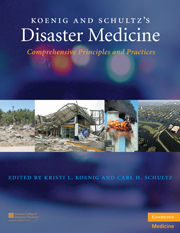Book contents
- Frontmatter
- Contents
- List of Contributors
- Contributor Biographies
- Foreword
- Preface
- Acknowledgments
- PART I CONCEPTUAL FRAMEWORK AND STRATEGIC OVERVIEW
- PART II OPERATIONAL ISSUES
- 9 Public Health and Emergency Management Systems
- 10 Legislative Authorities and Regulatory Issues
- 11 Syndromic Surveillance
- 12 Triage
- 13 Personal Protective Equipment
- 14 Decontamination
- 15 Quarantine
- 16 Mass Dispensing of Antibiotics and Vaccines
- 17 Management of Mass Gatherings
- 18 Transportation Disasters
- 19 Emergency Medical Services Scene Management
- 20 Healthcare Facility Disaster Management
- 21 Mass Fatality Management
- 22 Crisis and Emergency Risk Communication
- 23 Telemedicine and Telehealth Role in Public Health Emergencies
- 24 Complex Public Health Emergencies
- 25 Patient Identification and Tracking
- PART III CLINICAL MANAGEMENT
- Index
- Plate section
- References
25 - Patient Identification and Tracking
from PART II - OPERATIONAL ISSUES
Published online by Cambridge University Press: 05 August 2011
- Frontmatter
- Contents
- List of Contributors
- Contributor Biographies
- Foreword
- Preface
- Acknowledgments
- PART I CONCEPTUAL FRAMEWORK AND STRATEGIC OVERVIEW
- PART II OPERATIONAL ISSUES
- 9 Public Health and Emergency Management Systems
- 10 Legislative Authorities and Regulatory Issues
- 11 Syndromic Surveillance
- 12 Triage
- 13 Personal Protective Equipment
- 14 Decontamination
- 15 Quarantine
- 16 Mass Dispensing of Antibiotics and Vaccines
- 17 Management of Mass Gatherings
- 18 Transportation Disasters
- 19 Emergency Medical Services Scene Management
- 20 Healthcare Facility Disaster Management
- 21 Mass Fatality Management
- 22 Crisis and Emergency Risk Communication
- 23 Telemedicine and Telehealth Role in Public Health Emergencies
- 24 Complex Public Health Emergencies
- 25 Patient Identification and Tracking
- PART III CLINICAL MANAGEMENT
- Index
- Plate section
- References
Summary
OVERVIEW
Each year, many countries experience disasters including earthquakes, floods, fires, storms, and tornadoes, among others. These disasters vary in scope and magnitude and help shape the field of disaster management across these countries. Disaster planning previously based on limited experience and supposition is transitioning to planning based on evidence acquired from these actual catastrophic events. For the United States, at the time of this writing, the event that has most tested preparedness, response, and recovery is Hurricane Katrina along the Gulf coast in 2005. Hurricane Katrina provided disaster planners with first-hand experience in the challenges that arise after a major disaster that destroys significant infrastructure components of multiple communities.
One of the key issues illustrated by the study of Hurricane Katrina is that families and loved ones can and do get separated. In some instances, rescue workers sought to transport children to safety first, expecting that they would be reunited with parents within a brief period of time. Instead, confusion arose as to who was taken to which shelter. The same held true for hospitals evacuating patients or transferring patients to other locations. This created as much, or more, anxiety among hurricane victims than the destruction and loss of their property. As one news agency reported, “A centralized patient-tracking system did not exist. Without automated systems, it was almost impossible to know where evacuees were. Also, the federal government did not have a firm grasp on how many evacuees there were, and family reunification was difficult.....Data was spotty at command centers that state officials and organizations like the Red Cross set up.”
Keywords
- Type
- Chapter
- Information
- Koenig and Schultz's Disaster MedicineComprehensive Principles and Practices, pp. 377 - 388Publisher: Cambridge University PressPrint publication year: 2009



